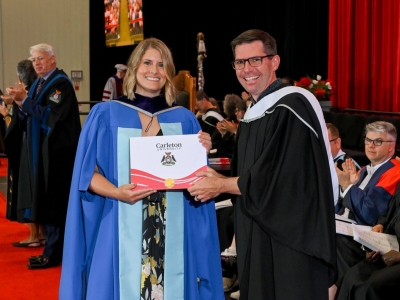Public health restrictions are being loosened across the country as COVID-19 cases fall and more Canadians are fully vaccinated. But as Carleton journalism instructors heard in a recent briefing with newsroom managers, for many reporters, it’s not yet time to return to normal or to newsrooms.
“Here in Alberta, as of (July 1) all health restrictions are being lifted, there will be no masking, there will be no physical distancing, everything is being lifted,” Stephanie Coombs, CBC Edmonton’s director of journalism and programming, told Carleton instructors.
“We’re going to keep a cautious approach.”
That means, for now, continuing to report remotely and, when that can’t be done, keeping a distance of two metres between reporters and the people they are interviewing when possible, aiming to stay outside and not inviting guests into studios.
“The safety of our staff remains paramount, the safety of the people that we’re interviewing, and our ability to serve the public, so all of the decisions that we’ve made around gathering (news) and around publishing are rooted in those principles,” Coombs said.
Last week Coombs, Ottawa Citizen and Sun editor in chief Nicole MacAdam and Global Press’s Washington, D.C.-based chief operating officer Laxmi Parthasarathy were part of a discussion about reporting safely through COVID-19 that was organized by faculty members Trish Audette-Longo and Christine Crowther.

“This session was a really important opportunity for us to connect with newsrooms to find out more about a year of change and get a better understanding what is happening with industry standards as public health guidance changes,” said Allan Thompson, the journalism program head.
MacAdam said safety is still the top priority for newsroom managers.
“Moving into the summer and the fall, it’s just making sure that we are being cautious in order to kind of keep people safe,” said MacAdam.
“If and when the mask mandate (is) lifted for vaccinated people for example, I think I would probably still encourage staff to wear a mask themselves and at least ask their sources to comply as well. These are conversations that we’re just starting to get into now as things are starting to shift.”
Parthasarathy, whose organization includes more than 40 bureaus in 12 countries including Nepal, Mongolia, Zimbabwe and Argentina, said she does not expect significant changes to health safety protocols that had reporters shifting to conduct remote rather than in-person interviews.
“There’s a lot that I think newsrooms can do to continue to keep reporters safe regardless of where they are in the world, because vaccinated or not I don’t think we’re out of this…” said Parthasarathy.
“I don’t see a dramatic shift in our response happening for at least another year… given that we are seeing a third wave in many of these countries, and nowhere near the kind of vaccination rates that we have in Canada and the U.S.”
In the last year, with university classes moved entirely online, students in Carleton’s journalism program have learned to report and work remotely, producing innovative audio, video and multimedia story packages from their homes all over the world.
For some, as professor Dave Tait pointed out during the discussion, that means there are new questions about what it might be like to do in-person on-the-ground reporting when they finally get to work in a newsroom.
Coombs said journalists in newsrooms know the circumstances under which students have been training, and they will be ready to help them adjust to in-person reporting.
“We’ve all managed to adapt to this (video conferencing and remote reporting), and I’d never done this for 20 years, and then had to do it. I think that we all very much understand that it will be new for those folks joining our newsrooms too,” Coombs said.
“We’ve had to be more flexible, and I think that if that results in us being more flexible about what skills students or young people are bringing into our newsrooms when they come, that probably is a good thing.”
All of the news leaders who met with Carleton’s journalism school talked about how newsroom conversations have changed through the pandemic.
“This has not been an easy 16 months with all of the restrictions and the fear and the anxiety around COVID, and then a number of really challenging stories to report on,” Coombs said. “This has prompted a much bigger conversation around mental health within our newsrooms and normalizing conversations about it, normalizing conversations that news might affect you.”
MacAdam said there have been more conversations and check-ins with reporters about how they are faring. “We’ve had a lot more conversations I would say in our newsroom than any newsroom that I’ve ever worked in about work-life balance, and mental health, and how important down-time is to kind of relieving pressure and stress.”
Parthasarathy said she has seen a shift in the last year toward more explicit care: more newsrooms asking how to support their employees, more funders asking newsrooms what they are doing to take care of their teams.
“I’m really excited about this moment of reflection that a lot of news organizations are finally doing around safety, security, and not just safety and security,” or just hostile environment training, she said.
“This is holistic, and so I think that’s something I’m excited about, I’m excited that there is a moment for people to really learn from this pandemic.”
Wednesday, July 7, 2021 in General, Journalism News
Share: Twitter, Facebook



